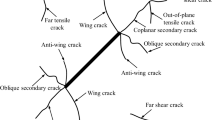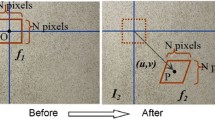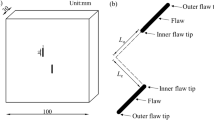Abstract
In this paper, uniaxial compression tests and digital image correlation (DIC) are combined to test samples of artificial rocks manufactured with preexisting cracks at different inclinations. The influence of these fractures on the mechanical properties of the rock and the deformation field in the rock were studied by recording and analyzing the forms of fracturing at specimen failure, crack propagation modes, crack initiation angles, and other features. The results show that the rupture modes of the specimens can be divided into two types: splitting and shear slip. The corresponding fracture types are wing fractures and secondary fractures. As the inclination angle of the prefabricated crack is increased, the wing crack propagation angle first decreases and then increases; the propagation angle is smallest when the inclination angle is 30°. The peak stress and the crack initiation stress ratios increases with the increase of the prefabricated fracture inclination angle .As a specimen is failing, the displacement in the specimen is mainly on the left side of the slip surface composed of a prefabricated crack and a wing crack and the lateral strain is mainly concentrated around the slip surface. This time interval (the time between peak stress and first appearance of a crack on the specimen’s surface) and the magnitude of the peak stress display a good positive correlation. DIC technology can be used to monitor this relationship and provide early warning of deformation and failure for a rock mass in a mine or other engineering project.















Similar content being viewed by others
References
Afolagboye LO, He JM, Wang SJ (2018) Crack initiation and coalescence behavior of two non-parallel flaws. Geotech Geol Eng 36(1):105–133
Amann F, Ündül Ö, Kaiser PK (2013) Crack initiation and crack propagation in heterogeneous sulfate-rich clay rocks. Rock Mech Rock Eng 47(5):1849–1865
Andreikiv AO (2000) Generalized griffith problem of shear with regard for the roughness of the crack surfaces. Mater Sci 36(2):210–217
Bieniawski ZT (1967a) Mechanism of brittle fracture of rock part I—theory of the fracture process. Int J Rock Mech Min Sci 4:395–406
Bieniawski ZT (1967b) Mechanism of brittle fracture of rock part II—experimental studies. Int J Rock Mech Min Sci 4:407–423
Bieniawski ZT (1967c) Mechanism of brittle fracture of rock part III—fracture in tension and under long-term loading. Int J Rock Mech Min Sci 4:425–430
Bobet A, Einstein HH (1998a) Fracture coalescence in rock-type materials under uniaxial and biaxial compression. Int J Rock Mech Min Sci 35(7):863–888
Bobet A, Einstein HH (1998b) Numerical modeling of fracture coalescence in a model rock material. Int J Fract 92:221–252
Cao P, Liu TY, Pu CZ, Lin H (2014) Crack propagation and coalescence of brittle rock-like specimens with pre-existing cracks in compression. Eng Geol 187:113–121
Chen LY, Liu JJ (2015) Numerical analysis on the crack propagation and failure characteristics of rocks with double fissures under the uniaxial compression. Petroleum 1(4):373–381
Fathi A, Moradian Z, Rivard P, Ballivy G, Boyd AJ (2016) Geometric effect of asperities on shear mechanism of rock joints. Rock Mech Rock Eng 49(3):801–820
Grasselli G (2006) Manuel Rocha medal recipient—shear strength of rock joints based on quantified surface description. Rock Mech Rock Eng 39(4):295–314
Grasselli G, Wirth J, Egger P (2002) Quantitative three-dimensional description of a rough surface and parameter evolution with shearing. Int J Rock Mech Min Sci 39(6):789–800
Guo ZB, Wang J, Zhang YL, Peng L (2014) Failure mechanism and constant resistance large deformation control measures of deep soft rock in Qingshui coal mine. J Min Saf Eng 31(6):945–949
Haeri H (2015a) Crack analysis of pre-cracked brittle specimens under biaxial compression. J Min Sci 51(6):1091–1100
Haeri H (2015b) Propagation mechanism of neighboring cracks in rock-like cylindrical specimens under uniaxial compression. J Min Sci 51(3):487–496
Haeri H (2015c) Simulating the crack propagation mechanism of pre-cracked concrete specimens under shear loading conditions. Strength Mater 47(4):618–632
Haeri H, Nemat S (1985) Compression-induced microcrack growth in brittle solids: axial splitting and shear failure. J Geophys Res 90(B4):3105–3125
Haeri H, Marji MF, Shahriar K, Moarefvand P (2014a) On the HDD analysis of micro crack initiation, propagation, and coalescence in brittle materials. Arab J Geosci 8(5):2841–2852
Haeri H, Shahriar K, Marji MF, Moarefvand P (2014b) Experimental and numerical study of crack propagation and coalescence in pre-cracked rock-like disks. Int J Rock Mech Min Sci 67:20–28
Haeri H, Shahriar K, Marji MF, Moarefvand P (2014c) On the strength and crack propagation process of the pre-cracked rock-like specimens under uniaxial compression. Strength Mater 46(1):140–152
Haeri H, Shahriar K, Marji MF, Moarefvand P (2014d) Cracks coalescence mechanism and cracks propagation paths in rock-like specimens containing pre-existing random cracks under compression. J Cent South Univ 21(6):2404–2414
Hall SA, Sanctis FD, Viggiani G (2006) Monitoring fracture propagation in a soft rock (Neapolitan Tuff) using acoustic emissions and digital images. Pure appl Geophys 163(10):2171–2204
Hoek E, Bieniawski ZT (1984) Brittle fracture propagation in rock under compression. Int J Fract 26:276–294
Huang JF, Chen GL, Zhao YH, Wang R (1990) An experimental study of the strain field development prior to failure of a marble plate under compression. Tectonophysics 175:269–284
Janeiro RP, Einstein HH (2010) Experimental study of the cracking behavior of specimens containing inclusions (under uniaxial compression). Int J Fract 164(1):83–102
Kabilan N, Muttharam M, Elamathi V (2017) Prediction of unconfined compressive strength for jointed rocks using point load index based on joint asperity angle. Geotech Geol Eng 35(6):2625–2636
Ke CC, Chen CS, Tu CH (2008) Determination of fracture toughness of anisotropic rocks by boundary element method. Rock Mech Rock Eng 41(4):509–538
Kotousov A, Neto LB, Rahman SS (2011) Theoretical model for roughness induced opening of cracks subjected to compression and shear loading. Int J Fract 172(1):9–18
Kulatilake PHSW, Balasingam P, Park J, Morgan R (2006) Natural rock joint roughness quantification through fractal techniques. Geotech Geol Eng 24(5):1181–1202
Lee H, Jeon S (2011) An experimental and numerical study of fracture coalescence in pre-cracked specimens under uniaxial compression. Int J Solids Struct 48(6):979–999
Li SY, He TM, Yin XC et al (2010) Introduction of rock fracture mechanics. Hefei, China
Li YP, Chen LZ, Wang YH (2015) Experimental research on pre-cracked marble under compression. Int J Solids Struct 42(9–10):2505–2516
Manouchehrian A, Marji MF (2012) Numerical analysis of confinement effect on crack propagation mechanism from a flaw in a pre-cracked rock under compression. Acta Mech Sin 28(5):1389–1397
Meng QB, Han LJ, Qiao WG, Fan JD (2013) The deformation failure mechanism and control techniques of soft rock in deep roadways in Zhaolou mine. J Min Saf Eng 30(2):165–172
Nasseri MHB, Grasselli G, Mohanty B (2010) Fracture toughness and fracture roughness in anisotropic granitic rocks. Rock Mech Rock Eng 43(4):403–415
Nguyen TL, Hall SA, Vacher P, Viggiani G (2011) Fracture mechanisms in soft rock: identification and quantification of evolving displacement discontinuities by extended digital image correlation. Tectonophysics 503(1):117–128
Nguyen VM, Konietzky H, Frühwirt T (2014) New methodology to characterize shear behavior of joints by combination of direct shear box testing and numerical simulations. Geotech Geol Eng 32(4):829–846
Park CH (2008) Coalescence of frictional fractures in rock materials. Purdue University Graduate School
Park CH, Bobet A (2009) Crack coalescence in specimens with open and closed flaws: a comparison. Int J Rock Mech Min Sci 46(5):819–829
Park CH, Bobet A (2010) Crack initiation, propagation and coalescence from frictional flaws in uniaxial compression. Eng Fract Mech 77(14):2727–2748
Pu CZ, Cao P (2012) Failure characteristics and its influencing factors of rock-like material with multi-fissures under uniaxial compression. Trans Nonferrous Met Soc China 22:185–191
Reyes O, Einstein HH (1991) Failure mechanism of fractured rock—a fracture coalescence model. In: 7th ISRM Congress, international society for rock mechanics and rock engineering, pp 333–340
Sahouryeh E, Dyskin AV, Germanovich LN (2002) Crack growth under biaxial compression. Eng Fract Mech 69:2187–2198
Sevillano JG, González D, Martínez-Esnaola JM (2007) Roughness of a mode I in-plane crack front propagating along a heterogeneous cohesive interface. J Comput Aided Mater Des 14(1):15–24
Shen BT, Stephansson O, Einstein HH, Ghahreman B (1995) Coalescence of fractures under shear stresses in experiments. J Geophys Res Solid Earth 100(B4):5975–5990
Sow D, Rivard P, Peyras L, Breul P, Moradian ZA, Bacconnet C, Ballivy G (2015) Comparison of joint shearing resistance obtained with the Barton and Choubey criterion and with direct shear tests. Rock Mech Rock Eng 49(8):3357–3361
Ündül Ö, Amann F, Aysal N, Plötze ML (2015) Micro-textural effects on crack initiation and crack propagation of andesitic rocks. Eng Geol 193:267–275
Wan W, Liu J, Liu J (2018) Effects of asperity angle and infill thickness on shear characteristics under constant normal load conditions. Geotech Geol Eng 36(4):2761–2767
Wang SW, Liu HD, Jiang T (2014) Large geomechanical model test on failure mechanism of rockburst tunnel under static and explosive loads. Chin J Rock Mech Eng 33(10):2095–2100
Wong RHC, Chau KT (1998) Crack coalescence in a rock-like material containing two cracks. Rock Mech Min Sci 35(2):147–164
Wong LNY, Einstein HH (2006) Fracturing behavior of prismatic specimens containing single flaws. In: Proceedings of the 41st US symposium on rock mechanics (USRMS): “50 years of rock mechanics—landmarks and future challenges”, Golden, Colorado, ARMA/USRMS 06-899
Wong LNY, Einstein HH (2009a) Crack coalescence in molded gypsum and Carrara marble: part 1. macroscopic observations and interpretation. Rock Mech Rock Eng 42:475–511
Wong LNY, Einstein HH (2009b) Crack coalescence in molded gypsum and Carrara marble: part 2—microscopic observations and interpretation. Rock Mech Rock Eng 42:513–545
Wong RHC, Chau KT, Tang CA, Lin P (2001) Analysis of crack coalescence in rock-like materials containing three flaws—part I experimental approach. Int J Rock Mech Min Sci 38:909–924
Wu ZJ, Wong LNY (2012) Frictional crack initiation and propagation analysis using the numerical manifold method. Comput Geotech 39:38–53
Yang SQ (2011) Crack coalescence behavior of brittle sandstone samples containing two coplanar fissures in the process of deformation failure. Eng Fract Mech 78:3059–3081
Yang SQ, Dai YH, Han LJ, ** ZQ (2009) Experimental study on mechanical behavior of brittle marble samples containing different flaws under uniaxial compression. Eng Fract Mech 76(12):1833–1845
Zhang X, Jiang QH, Chen N, Wei W, Feng XX (2016) Laboratory investigation on shear behavior of rock joints and a new peak shear strength criterion. Rock Mech Rock Eng 49(9):3495–3512
Zhuang XY, Chun JW, Zhu HH (2014) A comparative study on unfilled and filled crack propagation for rock-like brittle material. Theor Appl Fract Mech 72:110–120
Acknowledgements
The authors express their gratitude for the grants provided by the National Natural Science Foundation of China (Nos. 41602295, U1704243, 41602298,) and the Doctoral Student Innovation Foundation of North China University of Water Resources and Electric Power. The work was partially supported by the High-level Talents Foundation of the North China University of Water Resources and Electric Power (201501001). The Henan Institution of Higher Education Key Scientific Research Project (16A410004) are acknowledged The authors also wish to thank the anonymous reviewers for their constructive comments.
Author information
Authors and Affiliations
Corresponding author
Rights and permissions
About this article
Cite this article
Jiang, T., Pan, X., Lei, J. et al. Rupture and Crack Propagation in Artificial Soft Rock with Preexisting Fractures Under Uniaxial Compression. Geotech Geol Eng 37, 1943–1956 (2019). https://doi.org/10.1007/s10706-018-0736-z
Received:
Accepted:
Published:
Issue Date:
DOI: https://doi.org/10.1007/s10706-018-0736-z




